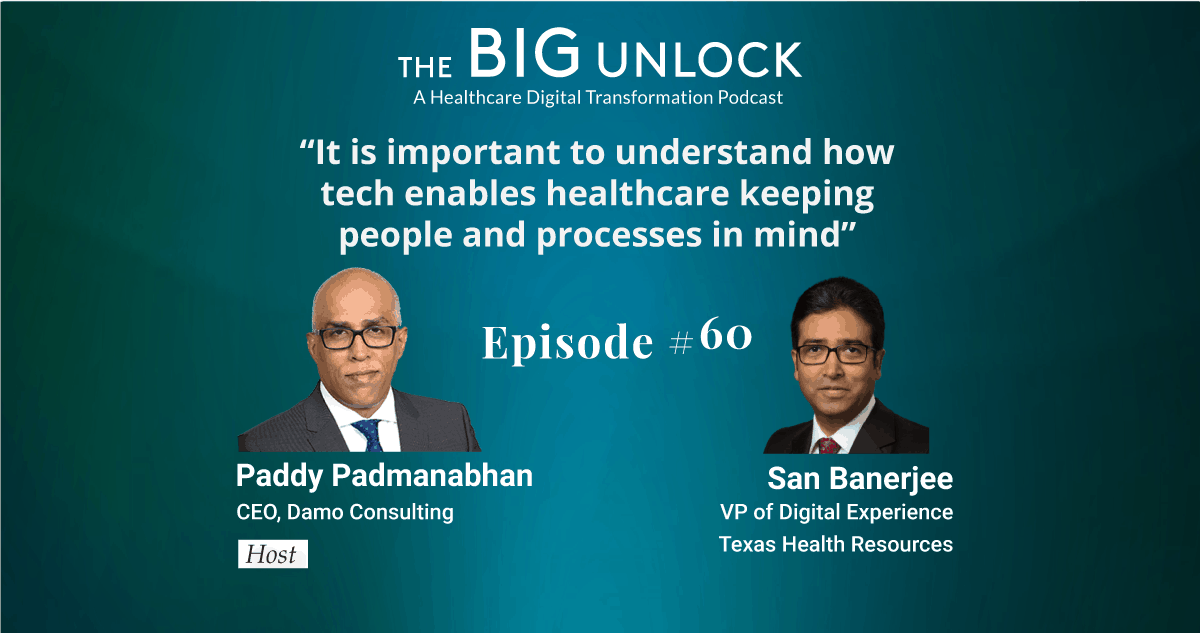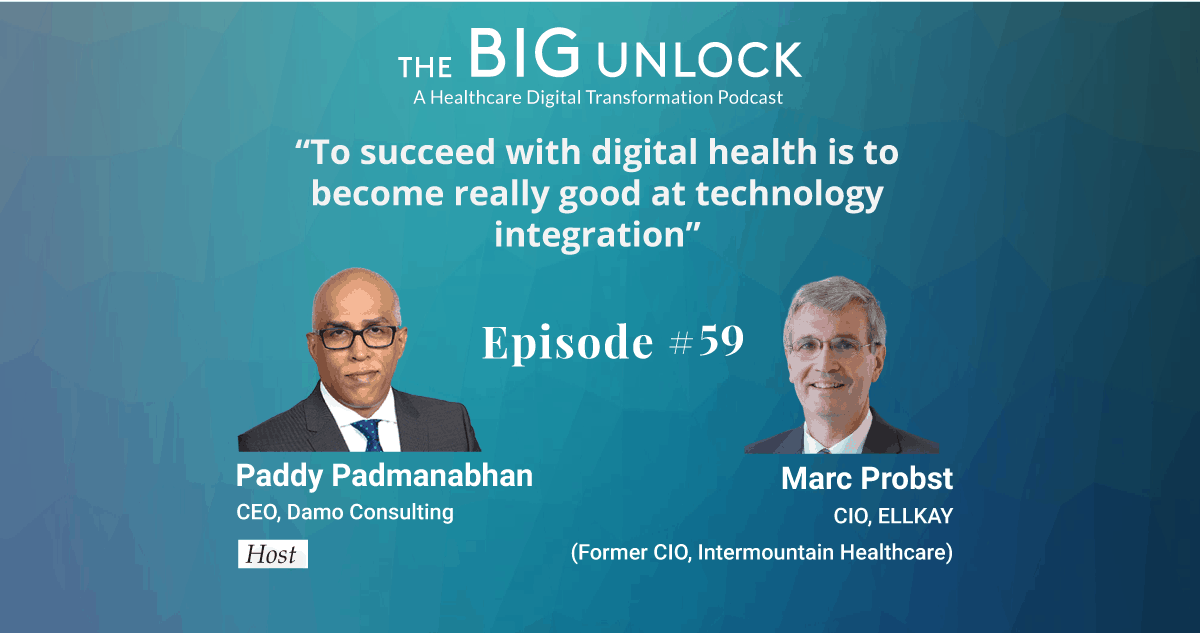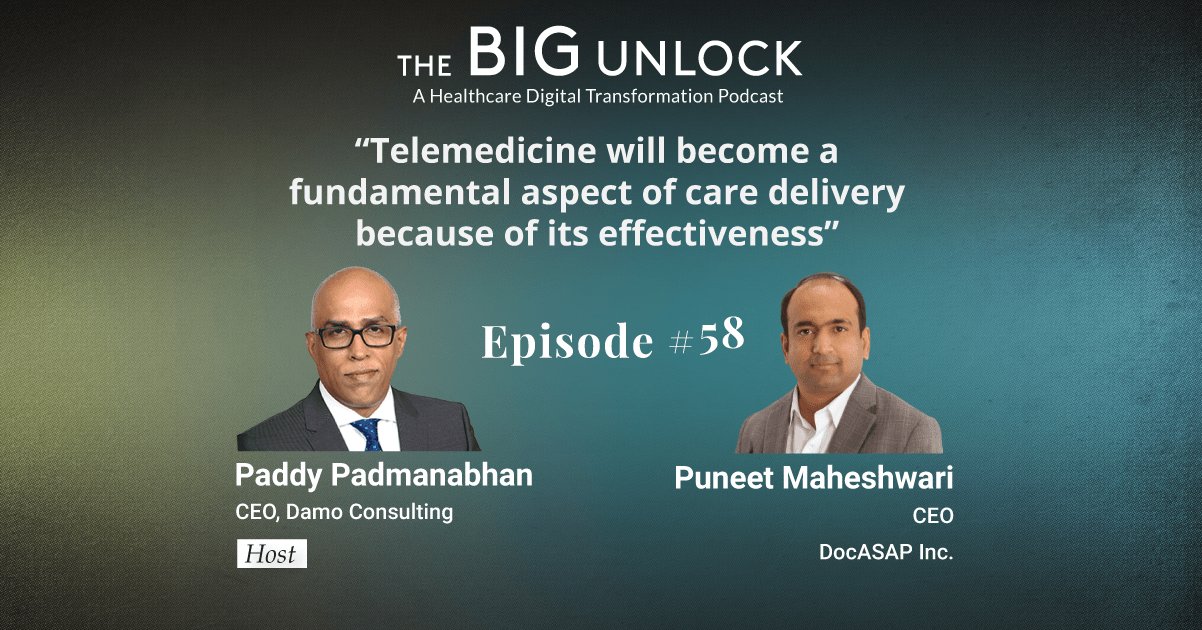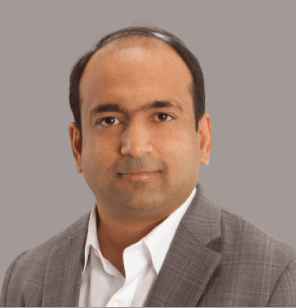Episode #60
Podcast with San Banerjee
VP of Digital Experience, Texas Health Resources
"It is important to understand how tech enables healthcare keeping people and processes in mind"
 Hosted by Paddy Padmanabhan
Hosted by Paddy Padmanabhan 
Share
In this episode, San Banerjee, Vice President of Digital Experience at Texas Health Resources, discusses how they create a connected ecosystem to provide a seamless digital experience for patients wherever they are through digital channels that includes virtual health.
Texas Health Resources completed 100,000 virtual visits in the first ninety days of the pandemic. San says that as we move forward in healthcare, people will get accustomed to using virtual care delivery mechanisms, which will increase its acceptance further. He defines digital front doors as an access mechanism for patients to get services they are looking for. On the other hand, from a consumer perspective, it is all about managing the consumer point of view to access the services that providers can offer.
Healthcare is not just about technology; it is a people-based business. San advises digital health startups to understand how technology enables the healthcare business while keeping in mind people and processes. Take a listen.
San Banerjee, VP of Digital Experience for Texas Health Resources in conversation with Paddy Padmanabhan, CEO of Damo Consulting on the Big Unlock Podcast – “It is important to understand how tech enables healthcare keeping people and processes in mind”
PP: Hello again, everyone, and welcome back to my podcast. This is Paddy, and it is my great privilege and honor to introduce my special guest today, San Banerjee, Vice President of Digital Experience for Texas Health Resources in Dallas. San, thank you so much for setting aside the time. And welcome to the show.
SB: I am glad to be here, Paddy. Always a pleasure talking to you.
PP: Thank you so much for that. So, let us start with this.
PP: Tell us a little bit about your role. What does the role of the VP of digital experience mean at THR?
SB: So, my role is responsible for creating seamless digital experiences for different channels through which our consumers and patients interact with us. And it also includes virtual health, which is the new dimension of care that we have embraced since last couple of years in terms of delivering care through virtual channels. So, at the end of the day, my role encompasses everything that Texas Health does on the digital side, including virtual.
PP: So, when I talk to health systems, the digital function sits in different parts of the organization and the roles are also defined a little bit differently in each health system. So, would you say your role is more focused on the marketing side of the digital experience? Or is it much more encompassing than that?
SB: It is more encompassing than that. It is like thinking about the channels as the avenues through which our consumers come and interact with us both on the consumer experience side and the clinical side of the house. So, think about this as a little broader than just the marketing side of the house.
PP: Right. Could you share maybe one or two examples of some of the big programs that are within the purview of your role just so that we get a sense of what the world looks like?
SB: Sure. So, a couple of programs that I have personally led and something that we are pursuing at this point of time. One is Hospital2Home program, an SMS text-based service for patients who are in hospitals. And then when they go back home, we really want to follow them to their home as well so that they can reach out when they need help. And behind the scenes, we have emergency physicians that are available on a text service along with them to provide the service. So, this is really trying to meet the patients through a digital channel, which is SMS and texting. Also, there are other programs that we are doing at this point. And we have kind of enabled many providers on the virtual channel, both on the virtual consults in the hospital as well as virtual through a direct to consumer kind of play. It is something that we are doing from a digital perspective to ensure that we become more and more relevant, especially in the COVID days when we want to distribute care, which is more convenient from a consumer perspective. Apart from that, we are kind of looking at where the world is going. So, if you look at the digital ecosystem, the ecosystem comprises of things like remote patient monitoring, which is needed for chronic care management, as well as a lot of capabilities around care coordination that can be done in digital way as well. So, we are looking at clinical coordination through digital channels. We are looking at consumer experience interactions or digital channel to make them better and creating those products and services so that it is more meaningful to our consumers and patients.
PP: Right. And these all seem like the sort of high value, high impact programs that we are seeing other health systems investing in as well. In the wake of COVID-19, have you started seeing a significant sort of shift and a long-term shift towards virtual care models? Or do you think that some of it is going to kind of go back to more of an in-person kind of an experience? In other words, is this a long-term shift that you’re anticipating and proactively preparing for?
SB: Yeah, the answer is yes. We have been anticipating this for some time now. And we are prepared really well because we have been working on this for a while to ensure we put the right interventions that are needed to be able to come really good out of this pandemic. As you probably know, pandemic came in and we adopted an approach of relooking at what we have in our toolkit to bring all the things together in service of our patients. So it was less of getting new technology from outside, but looking at the technology that we already have and tried to put all those things together in the right order to be meaningful to our patients. And that’s what we did. Eventually, we will probably reconcile a lot of things so that we create our own state as far as a lot of those initiatives are concerned. But the first order of business was to really create something very quickly. And I always say that when you are in a pandemic, you have to look at bringing some technology in a meaningful manner so that it can be created and ensure that it kind of delivers what you need at that point of time.
PP: Right. And of course, this is technology enabled without a doubt. And all the virtual care models are going to have a significant implication in terms of technology investments, making the technology work seamlessly and so on. So, how does THR go about assessing your technology choices and implementing your digital programs? What do you see as the role of enterprise IT and more specifically, EHR systems in driving your digital journey and your digital road at THR?
SB: I think it is a very integrated way of looking at this. So, the enterprise IT team pretty much worked very closely hand-in-hand with the digital team because it is a connected ecosystem, if you think about it that way. We keep in mind in terms of the EHRs that we have and how does our digital initiatives work and operate without each other in the right order? Because that has a lot of single source of truth. And in many cases, as well as and there are changes happening on that all the time. So, we have a pure said governance in the way that we can work with the IT team. And the IT team and digital team kind of complements each other to that extent to ensure that we created a connected ecosystem. So, all this process is in service of getting a connected ecosystem, which basically starts with a consumer standpoint. It also connects all the clinical workflows that basically goes into EHR. And this is a strategy that we believe in. And we kind of bring the people in that can complement each other both the digital side which is just sitting on the business side of the ideas so that we can achieve this objective.
PP: Yeah, it’s probably a segue into something that I was going to ask here anyway. Everyone acknowledges that healthcare has traditionally been behind other sectors when it comes to consumer engagement. The work that my firm does with health systems, in particular seems to indicate that, even within healthcare, health systems are probably a little bit behind let’s say health plans. And then you can tell me that because you have a background in health plans as well. And we’ll talk about that. But what makes it so hard to create these seamless experiences? Is that the fragmentation of the technology solutions landscape? Is it more the fragmentation of the way the efforts are coordinated within a health system? Not speaking specifically about THR, but in general what do you see as the big challenges of creating these seamless experiences that we are so used to when we talk about Amazon and Starbucks and Apple and all of that?
SB: I think it is a couple of things. Number one, the information sharing between the payer and the providers. I think there’s a lot of opportunity there in terms of how information gets shared. And these are two worlds and rightfully said, because that’s how the whole ecosystem and the value chain really works. The second is the ability for keeping patient outcomes in mind, between both the ecosystems, is very important. So, when you talk about connecting between a payer and a provider, it has to happen with some objective in mind. If we all keep patient outcome as an objective in mind, then obviously the integration becomes a lot simpler and easier. And the third thing is that the focus on value definition in terms of what value does it bring to the payer and the provider and the patient? We have to keep all those three things in perspective. And many times, there is misalignment of those objectives because of either the way the incentives really work, the way the reimbursement really works, the way the claims really work across the system. So, it is important that those objectives are aligned. And if those objective alignment, can be done, I think then the integration becomes a lot easier in terms of the payer and the provider work. And obviously, from a consumer perspective, they don’t care whether it is a payer problem or a provider problem. They need to get a service and they want the ease of service and the way it happens. For them, a retail works. So, I think there are some serious conversations that are needed in terms of how that interoperability really works between payer and provider. And I think those things are already started from CMS and other agencies. And this will become more and more better as we go by.
PP: Right. And interoperability, of course, is unfinished business. And you alluded to the CMS the final ruling, I believe, which comes into effect next year. And they had to push it back from this year. Well, we’ve come a long way from what it used to be maybe three years ago. But there is still a lot of unfinished business when it comes to interoperability within the provider landscape. And now you’re talking about provider payer collaboration as well. What is the view like from the payer side? I know you spent many years on the payer side. What is the view like and what gives us hope today that this current sort of friction, if you will, in payer provider collaboration is headed in the right direction in terms of a resolution in favor of patient outcomes?
SB: Paddy, I think it is a couple of things. One is the move towards value-based care, which is getting pushed by the payer side of the business, will really help active collaboration on patient outcomes. That’s one dimension I see being more and more. The second is, payers are really getting into a place where they are embracing a lot of patient engagement strategies where they want providers to participate as well. So, creating those narrow networks, for example, where it is close interactions with providers, ensuring that the right metrics are aligned, which means data sharing on both sides. And also, the payers are looking at getting more and more accustomed to doing partnerships beyond that ecosystem, whether it is a health and wellness partner or any other ecosystem partner. So, it is not a foreign concept of being able to share data outside the premises. So, with all of that, three things that I’ve talked about, I think I’m becoming more and more hopeful that this will become more on a progressive path in terms of how we see the interactions happen between the payer and the provider. And I think we will improve more and more going forward.
PP: Right. Let’s talk about the consumers themselves, because they are the third leg in the stool, if you will. Based on all the research that you do as part of your role. How are consumers perceiving the shift towards virtual? Do you see differences between demographics or parts of your own area served? How are consumers responding to this sort of dramatic shift, if you will, towards the virtualization of care? Are they ready for it? Do they appreciate it?
SB: I think I would say that the adoption of those kind of care delivery mechanisms is increasing day by day. I think among patients and consumers, because of COVID-19 the pandemic, the acceptance of new care delivery avenues have definitely increased. I will also say that it is also a mixed bag. There are consumers that can adopt this pretty quickly and there are consumers who really like to go back to an office setting. So, and this is purely consumer preference at this point of time. But the percentage of people that have adopted virtual really well and keeping themselves safe by staying out of offices is definitely a very positive percentage from an increase standpoint. And I see that going more and more. And I think it is also letting consumers to shift their preferences as well. I go back to that example of Apple, when Apple brought their phone nobody knew how to use it. So, Apple trained people to use the phone. In the same way, virtual will follow the same path. People will get trained to use a different delivery mechanism, which is virtual in this case. And people will get trained more and more. Once they get more and more trained, acceptance will go high as well. Because now they know how to use it. They’ll become more comfortable with it. And influence other people to adopt as well.
PP: And the training aspect of it applies on the caregiver side as well. Right? From everything that I’ve seen as part of our work, implementing a telehealth technology and expecting everyone to use it. Just not very realistic, because you have to know there’s a whole bunch of protocols to get on virtual care platform to initiate contact, to make sure that, both parties have access to the tool and they’re coming along on at the same time. And then training caregivers to be able to use the platform. There’s a lot of work behind the scenes. It sorts of gets missed in this in this whole discussion around. Hey, the technology is cool, don’t know why we didn’t we do this before? But then there’s so much heavy lift that happens in the background. Is that a fair statement?
SB: Yes, that’s a very fair statement. That is what is happening on the ground at this point in terms of how consumers are interacting and behaving.
PP: Right. So, when we talk about consumers and their adoption rates for telehealth or virtual care models, the term that often gets mentioned is digital front doors. And that is kind of your world. So, if we talk about digital front doors, firstly how would you define the term digital front door because I hear different definitions, although everyone uses the term. And what do you think are maybe the top two or three high impact engagement opportunities in a digital front door program in your experience and your view?
SB: So the way I define digital front door is a kind of a access mechanism that consumers really can come through, whether it is a known consumer, unknown consumer, and through that particular channel of the door and basically get access to the services that they are looking for. And I think the key perspective of digital front door is to ensure that whatever services and whatever conditions any health system provider really can service, they are all available in there in terms of how consumers are going to use it. So, this is more from a consumer standpoint than a provider standpoint. Typically, most of the provider groups and even health systems put out things which are primarily a reflection of what services that they have. So, if you put your lens in terms of looking from a consumer perspective, we have a very different definition to it. So, digital front door is all about managing or balancing that consumer point of view of what they’re looking from an access standpoint and matching that with what providers really can provide and creating that seamless experience. Another part of your question was what is the most important thing from a digital front door? The most important thing from a digital front door, in my mind is the ability for somebody to schedule an appointment. And basically, providing them the access to the provider that they are looking to really get in a very easy way in a consumer term. And consumer terms can be defined as different types of consumers you have and based on that; it is not a one size fit all. So, you’re now creating this a la carte set of services that you have to create to really address all the consumers so that they can get access to the providers. That’s the basic minimum thing that you need to have on the consumer front door to be able to be relevant to the consumers.
PP: Right. So, find a doctor, make your payment online, schedule the appointment. All of that happens very, very seamlessly. And then potentially you actually even do the consult through a telehealth platform. Is that kind of what your reference to?
SB: That is correct.
PP: Right. And that kind of aligns up to what we’re seeing. And of course, I think COVID -19 as a black swan event, has accelerated the adoption of these modalities for both consumers and healthcare providers alike. And it was coming along at a certain pace but it looks like it has accelerated. And people tell me that what was supposed to happen over the next five years suddenly got compressed to a five-month sort of timeframe. Is that experience you went through at THR as well, or were you’re already well ahead of the curve and you didn’t really have to kind of bend over backwards to stand up these capabilities?
SB: Well, that’s the exact experience we went through. So, we probably achieved so much in the first 90 days that we have not achieved in the last three years. So, just to give you some examples here. We completed hundred thousand virtual visits starting March and ending in August. A hundred thousand virtual visits and everything was created. More than 2000 providers were onboarded. All this happened within 90 days.
PP: How did this compare with the same period last year? I’m just curious. I know the numbers are going to be wide but I’m just curious.
SB: Last year, it was it was pretty non- existent. Right. We did not have a lot of virtual visits last year like it was in tens and hundreds. Right. Compared to 100,000 that we did this year.
PP: Wow, that is a wild story. And the funny part is that you’re not alone. It looks like many health systems across the country went through that exact same experience. All of a sudden, their worlds have transformed completely over the last six months or so. So, let’s just talk a little bit about the competitive landscape for healthcare services. I just want your views on what’s going on with your own marketplace. We have a number of nontraditional players that includes nontraditional, traditional enterprises. So, I’m talking about Walgreens, Walmart, those kinds of entities that are suddenly making a bigger play in the primary care space. And then you’ve got technology firms that are kind of getting into this space in their own ways. Examples of that being, Microsoft partnership with Epic, for instance, to launch telehealth visits from right inside Microsoft teams, which was announced just a couple of days ago. And then you’ve got Apple. And now Amazon everyone making their own place. What is your general assessment in terms of, what that implies for health systems such as THR in terms of changing the way you engage with your patients? And do you think that the primary care pie is going to get kind of redistributed among the broader set of participants that goes well beyond traditional health systems.
SB: Well, I think definitely that’s the way I look at it, that is definitely a market dynamics and a pressure in terms of how the market is going to change. Obviously, all these new players bring in new dimensions and skills into the market. And the way I look at this is, there’ll be a lot more fragmentation in terms of how the services will be provided to the patients and which has a good and a bad side. The good side is fragmentation leads to not being able to create seamless experiences. But the good side is it creates a lot of cost pressures on the traditional players, which can be really better on a payer and the consumer side. So, I think it is a pretty real thing in terms of how some of these players can disrupt.
But again, it is also in terms of how they are able to bring in some of those skills that can help integrate some of the services that is being talked about to really having a meaningful impact on the existing markets. And I think there will be a shift in terms of how convenient care, value-based care are going to be structured in the marketplace. And some of these players may have a higher advantage because they are coming into the business with pretty less overheads in terms of how they are structured. So, it will be interesting to really see how things shape up over a period of time. But at this point of time, it is a real market dynamic which we are all looking at.
PP: Right. We are coming up to the end of our time here, and I wanted to touch on one more topic. In your role, I’m sure you’ll get calls from a lot of innovative startups that have built tools, that can help you improve your patient engagement and patient experience and specifically from a digital front door standpoint. Now I have a two-part question. The first part of the question is, do you look at EHR as your default platform first before you look outside for a tool that could, perform a certain functionality? And the second question is, what is your advice to startups that have an innovative tool that can improve your patient experience and want to do business with you? What is your advice to companies like that? When should they come to you and how should they go about engaging with you?
SB: Well, great questions. So, the answer to the first question is yes, we look at the EHR to start with. And many times, we know the answers. And many times, many things are not addressed by the EHR because the way EHRs are set up from a business perspective. We look at either point solutions that really can bring what we are looking for or solutions that can integrate with each other to deliver what you’re looking for. That’s the kind of approach we use. In terms of my advice to any startup, I think healthcare is not just tech, it has people and process. I think whenever somebody is thinking about a product which is primarily a tech product, they also think about those two dimensions as well. A good product in my mind, which is meaningful for a provider like us, is a product which really has thought through all the three dimensions. And holistically kind of connects everything together to really kind of deliver the value that we need. Otherwise, it becomes a tech product. It cannot be integrated. There is a longer lead time to sell and stuff like that. So, that would be my advice. And healthcare is a people-based business, and it is very important to understand how tech enables this business where you have to keep people and process in mind.
PP: Right. That’s well said. In fact, one of the things that I tell people as part of our workers, digital transformation is IT enabled. But it’s not an IT project. It’s not necessarily IT led either. And, someone told me, one of the CEOs I talked to, digital transmission is like 80 percent people, 15 percent process and maybe 5 percent tech. And that’s kind of what you essentially said and they put numbers on it. But directionally, those are the two important dimensions and the tech is almost easy in comparison. Is that something you would agree with?
SB: That is, I agree with. Yes, absolutely.
PP: Fantastic. San, it has been such a pleasure talking to you. Thank you so much for sharing your insights and your experience. And wow one hundred thousand visits in 90 days, going up from zero to hundred thousand. That must have been a wild experience and I’m sure that experience alone puts you in a really, really strong place for the future. All the very best to you and your team and the work that you’re doing. We’ll be following very closely and maybe we’ll get back together and talk about it in another six months from now.
SB: That sounds great Paddy and I really appreciate you reaching out and always a pleasure talking to you and thanks for sharing this. As I said, if there is any question that comes and anyone wants to reach out, I can be reached at LinkedIn as San Banerjee and my Twitter handle is @banerjee_san.
PP: Thank you.
SB: Awesome. Thank you so much. Bye.
We hope you enjoyed this podcast. Subscribe to our podcast series at www.thebigunlock.com and write to us at info@thebigunlock.com
Disclaimer: This Q&A has been derived from the podcast transcript and has been edited for readability and claritytechnology
About our guest

San Banerjee is VP Digital Experience for Texas Health Resources and leads the Digital Health experience for the health system, its subsidiaries, and joint ventures. He has more than 20 years of experience in digital transformation, product development driving digital business, information technology delivery, and management consulting, across regulated industries including healthcare and financial services.
Prior to Texas Health he served as the Head of Consumer Digital Solutions of Humana where he led the execution of Humana’s digital strategy through innovation and creating cross-channel digital capabilities/experiences with consumers, providers, agents/brokers, and associates. Under his leadership, Humana launched its first healthcare rewards program for Medicare and group members with more than a million members on the platform. He also led a major initiative to drive e-adoption among prospects and members by digitizing plan, insurance, and care documents, which resulted in significant operating expense savings.
San has many years of experience in financial services prior to Humana where he has worked for Barclays Bank, SunGard Financial Systems, Infosys, and Goldman Sachs.
San holds a Bachelor of Computer Science Engineering, as well as a Master of Business Administration with specialization in marketing from Southern Methodist University. He is also a certified consumer experience professional (CXP) and SAFe® Agilist. San has penned several research papers, and has even filed a few patents on mobile technology, digital channel, and payments.
Recent Episodes
About the host
Paddy is the co-author of Healthcare Digital Transformation – How Consumerism, Technology and Pandemic are Accelerating the Future (Taylor & Francis, Aug 2020), along with Edward W. Marx. Paddy is also the author of the best-selling book The Big Unlock – Harnessing Data and Growing Digital Health Businesses in a Value-based Care Era (Archway Publishing, 2017). He is the host of the highly subscribed The Big Unlock podcast on digital transformation in healthcare featuring C-level executives from the healthcare and technology sectors. He is widely published and has a by-lined column in CIO Magazine and other respected industry publications.














